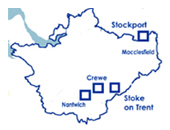Spondylosis
Spondylosis is a term used to describe the narrowing of the discs between your vertebrae due usually to degenerative disc disease.
A disc sits between the bones of the back or neck (called vertebrae). This intervertebral disc is made of a fibrous connective tissue around the outside of a spongy central part called the nucleus. These fibres help the disc withstand tension and pressure, like a shock absorber. Between the vertebrae of each spinal segment at the back are two joints called facets. The alignment of the facet joints of the spine allows movement of the back or neck to bend or rotate.
Our discs change with age, like any other aging process or wear and tear, but this aging can be accelerated by previous injuries. Smoking or a family history of degenerative disc disease can also accelerate the normal wear and tear processes.
In middle age the central nucleus starts to dry up, changing its nature from a squidgy toothpaste-like material to a tougher, stiffer fibrous substance. The discs gradually lose their ability to absorb shock, leading to a shrinking compression of the disc. This allows the bones or joints of the spine to start to rub against each other.
This wear and tear doesn't automatically mean that you will experience pain. It is common to see severe degeneration on X ray but the patient may have little or no pain. The discomfort of disc degenerative disease usually comes from the soft-tissues of the spine such as the ligaments (the tough fibrous rubber-band like structures which hold the bones together), the facet joints or the disc itself.
Symptoms of Degenerative disc disease
Stiffness or pain at the base of the back or neck with associated muscle tightness and discomfort around the area. Initially the symptoms only last a few days and usually eases with rest. Initially this can start in our 30's. Gradually the pain becomes more frequent over the years and becomes more painful. It can travel into the buttocks or leg from the back, or into the shoulders or arm in the case of the neck.
Your Osteopath will take a careful case history and then examine you in great detail, noting your ranges and quality of movement. He will do minor tests and in rare cases may request an X ray.
When a diagnosis has been reached , your Osteopath will discuss the treatment options with you.
Although degenerative disc disease cannot be cured, your Osteopath should normally be able to reduce your symptoms to a pain-free level and give you advice and exercise to help prevent future problems.
This is one of the most common conditions that Osteopaths treat and nearly always a patient can be helped by carefully prescribed Osteopathic treatment and advice!


